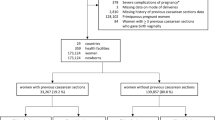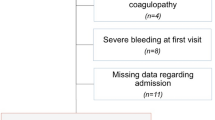Abstract
Objective:
To describe maternal and perinatal morbidity and mortality associated with uterine rupture (UR) among women with prior cesarean/s, singleton term pregnancies and a trial of labor after cesarean (TOLAC).
Study Design:
Linked hospital discharge files and birth/fetal death certificates identified potential cases of UR in Massachusetts from 1990 to 1998 with definitive identification by medical record abstraction.
Result:
Among the 347 identified URs, severe outcomes occurred in 86 cases (25%), in 49 (14%) of mothers and 49 (14%) of infants. Of the infants, 25 were discharged with a good prognosis. Maternal age and interdelivery interval <18 months (relative risk (RR)=1.55; 95% confidence interval (CI): 1.05, 2.31) were associated with a severe outcome. The type of hospital and labor were not associated with the increased risk of a severe outcome.
Conclusion:
Assuming a 0.7% UR rate among women at term with a TOLAC, the increased rate of severe outcomes related to UR above the baseline risk of elective cesarean is estimated to be 1.3 per 1000 TOLACs.
This is a preview of subscription content, access via your institution
Access options
Subscribe to this journal
Receive 12 print issues and online access
$259.00 per year
only $21.58 per issue
Buy this article
- Purchase on Springer Link
- Instant access to full article PDF
Prices may be subject to local taxes which are calculated during checkout

Similar content being viewed by others
References
Guise J-M, Denman MA, Emeis C, Marshall N, Walker M, Fu R et al. Vaginal birth after cesarean: new sights on maternal and neonatal outcomes. Obstet Gynecol 2010; 115 (6): 1267–1278.
Landon MB, Hauth JC, Leveno KJ, Spong CY, Leindecker S, Varner MW et al. Maternal and perinatal outcomes associated with a trial of labor after prior cesarean delivery. N Engl J Med 2004; 351 (25): 2581–2589.
Hamilton E, Martin JA, Ventura SJ . Births: preliminary data for 2006. Nat Vit Stat Rep 2007; 55: 1–18.
Martin JA, Hamilton BE, Sutton PD, Ventura SJ, Menacker F, Kirmeyer S et al. Births: final data for 2005. Nat Vit Stat Rep 2007; 56 (6): 1–103.
Kieser KE, Baskett TF . A 10-year population-based study of uterine rupture. Obstet Gynecol 2002; 100 (4): 749–753.
Kwee A, Bots ML, Visser GHA, Bruinse HW . Uterine rupture and its complications in the Netherlands: a prospective study. Eur J Obstet Gynecol Reprod Biol 2006; 128 (1-2): 257–261.
Weiss J, Nannini A, Fogerty S, Frigoletto F, Roberts D, Ringer S et al. Use of hospital discharge data to monitor uterine rupture--Massachusetts, 1990-1997. MMWR 2000; 49 (12): 245–248.
Maryland Quality Indicator Project. Acute Care Indicator Implementation Manual. Mayland Hospital Association: Elkridge, MD, 2001.
Sarnat HB, Sarnat MS . Neonatal encephalopathy following fetal distress. A clinical and electroencephalographic study. Arch Neurol 1976; 33 (10): 696–705.
Executive Office of Health and Human Services. Massachusetts Perinatal Licensure Regulations, 105 CMR 130.600-699. Massachusetts Department of Public Health, Boston, MA.
Say L, Pattinson RC, Gulmezoglu AM . WHO systematic review of maternal morbidity and mortality: the prevalence of severe acute maternal morbidity (near miss). BMC Reproductive Health 2004; 1: 3.
Cahill AG, Stamilio DM, Odibo AO, Peipert JF, Stevens EJ, Macones GA . Does a maximum dose of oxytocin affect risk for uterine rupture in candidates for vaginal birth after cesarean delivery. Am J Obstet Gynecol 2007; 197 (5): 495, e1-5.
Zelop CM, Shipp TD, Repke JT, Cohen A, Caughey AB, Lieberman E . Uterine rupture during induced or augmented labor in gravid women with one prior cesarean delivery. Am J Obstet Gynecol 1999; 181 (4): 882–886.
Macones GA, Peipert J, Nelson DB, Odibo A, Stevens EJ, Stamilio DM et al. Maternal complications with vaginal birth after cesarean delivery: a multicenter study. Am J Obstet Gynecol 2005; 193 (5): 1656–1662.
Srinivas SK, Stamilio DM, Sammel MD, Stevens EJ, Peipert JF, Odibo AO et al. Vaginal birth after caesarean delivery: does maternal age affect safety and success? Paediatr Perinat Epidemiol 2007; 21 (2): 114–120.
Bujold E, Mehta SH, Bujold C, Gauthier RJ . Interdelivery interval and uterine rupture. Am J Obstet Gynecol 2002; 187 (5): 1199–1202.
Shipp TD, Zelop CM, Repke JT, Cohen A, Lieberman E . Interdelivery interval and risk of symptomatic uterine rupture. Obstet Gynecol 2001; 97 (2): 175–177.
Stamilio DM, DeFranco E, Pare E, Odibo AO, Peipert JF, Allsworth JE et al. Short interpregnancy interval: risk of uterine rupture and complications of vaginal birth after cesarean delivery. Obstet Gynecol 2007; 110 (5): 1075–1082.
Tita AT, Landon MB, Spong CY, Lai Y, Leveno KJ, Varner MW et al. Timing of elective repeat cesarean delivery at term and neonatal outcomes. N Engl J Med 2009; 360 (2): 111–120.
Acknowledgements
This study was funded in part by Cooperative Agreement #S1012-19/19 between the Centers for Disease Control and Prevention, the Association of Schools of Public Health and the Boston University School of Public Health. We thank members of the MMMRC members and staff for their important contribution to this study, and Drs Elizabeth Brown, neonatologist, and Gary Krauss, Ob-Gyn, who assisted in the assessments of relatedness of outcomes, and Timothy Heeren, PhD, for statistical consultation.
Author information
Authors and Affiliations
Corresponding author
Ethics declarations
Competing interests
The authors declare no conflict of interest.
Rights and permissions
About this article
Cite this article
Barger, M., Nannini, A., Weiss, J. et al. Severe maternal and perinatal outcomes from uterine rupture among women at term with a trial of labor. J Perinatol 32, 837–843 (2012). https://doi.org/10.1038/jp.2012.2
Received:
Revised:
Accepted:
Published:
Issue Date:
DOI: https://doi.org/10.1038/jp.2012.2
Keywords
This article is cited by
-
Trial of labour after caesarean section and the risk of neonatal and infant death: a nationwide cohort study
BMC Pregnancy and Childbirth (2017)



